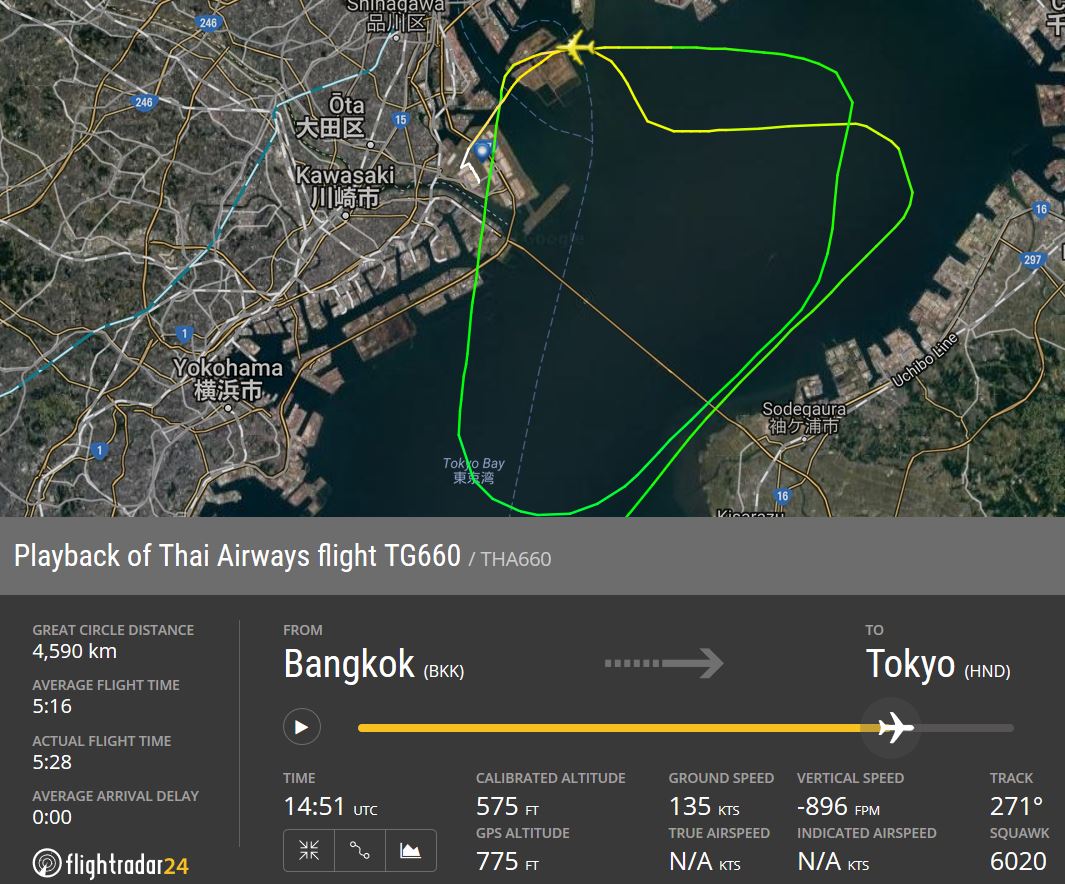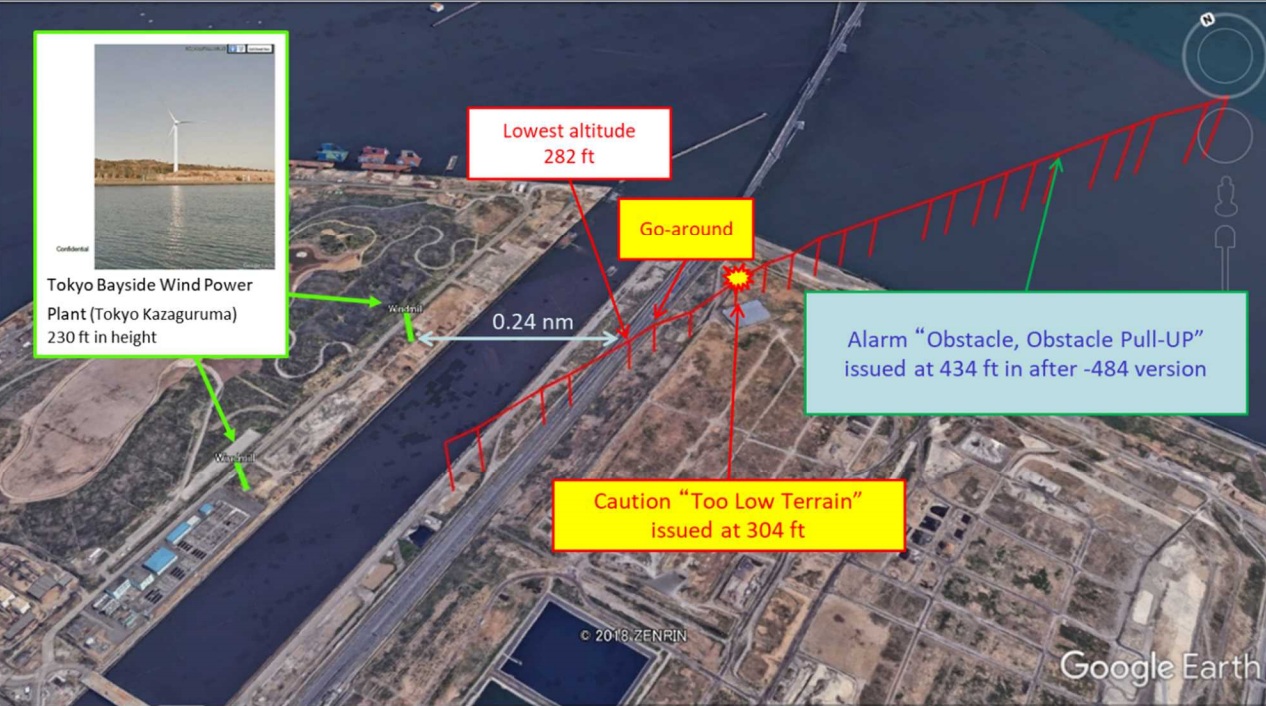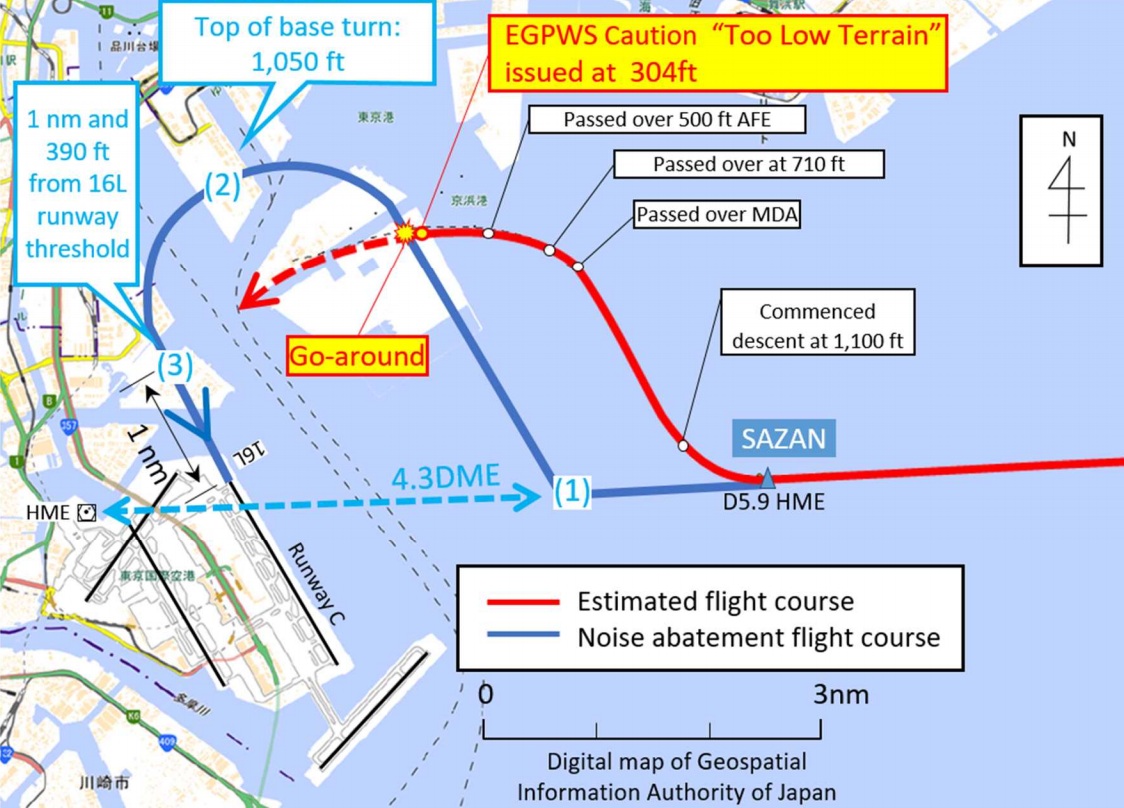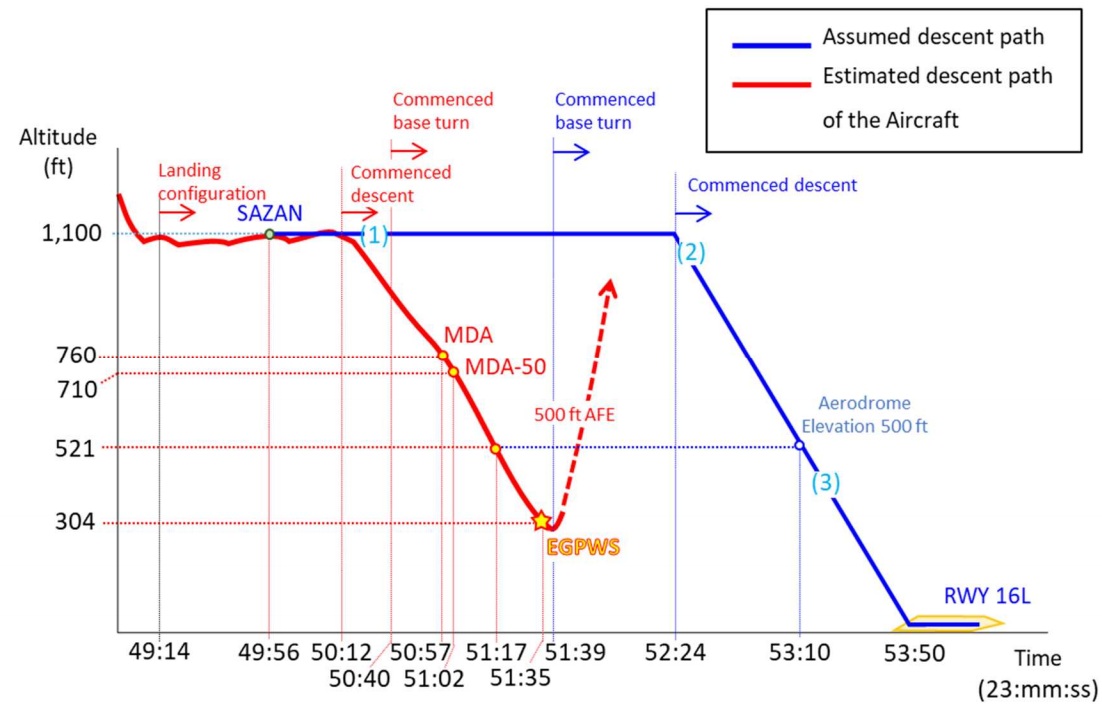
ASN Wikibase Occurrence # 209441
This information is added by users of ASN. Neither ASN nor the Flight Safety Foundation are responsible for the completeness or correctness of this information.
If you feel this information is incomplete or incorrect, you can submit corrected information.
| Date: | Wednesday 11 April 2018 |
| Time: | 23:50 LT |
| Type: |  Boeing 747-4D7 |
| Owner/operator: | Thai Airways International |
| Registration: | HS-TGX |
| MSN: | 27725/1134 |
| Fatalities: | Fatalities: 0 / Occupants: 384 |
| Aircraft damage: | None |
| Category: | Serious incident |
| Location: | 8km northeast of Tokyo International Airport/Haneda (HND/RJTT) -
 Japan Japan
|
| Phase: | Approach |
| Nature: | Passenger - Scheduled |
| Departure airport: | Bangkok-Suvarnabhumi International Airport (BKK/VTBS) |
| Tokyo International Airport/Haneda (HND/RJTT), Japan | |
| Investigating agency: | JTSB |
| Confidence Rating: |
A Boeing 747-400 of Thai Airways International, operating flight THA/TG660 from Bangkok/Suvarnabhumi, Thailand to Tokyo/Haneda, Japan, experienced "Too Low" EGPWS warning during a night time approach to runway 16L of Haneda.
The flight was cleared for a VOR A approach for runway 16L after DARKS arrival. The aircraft arrived from the east and after passing over DARKS, aircraft have to cross SAZAN at or above an altitude of 1,100 ft while descending at a bearing of 274 ° toward Haneda VOR/DME (HME), and enter a circling approach (down-wind leg of runway 16L) after
visually recognizing runway 16L and with turning to the right. Normally, pilots visually select a route in circling approach and approach landing runway. However, noise abatement procedures require aircraft to fly along or inside a specified course for landing on runway 16L.
In circling, MDA is established as a minimum altitude applied until commencing visual descending for landing. MDA in this approach procedure is 760 ft.
TG660 howefer, immediately began turning on the down-wind leg of runway 16L directly after crossing SAZAN, which was outside the specified approach procedure.
Both the PIC and the FO then visually recognized lights that appeared to be the approach guidance lights ahead in the left. The PIC commenced the base turn by turning left in an attempt to enter inside the designated course using the landmark beacon as a reference because the PIC realized that the aircraft was off the designated course.
The FO performed altiude an call-out passing over 500 ft. The PIC continued the approach saying, "Check, continue” in response to the call-out of the FO because runway was always visible.
Tokyo Tower then radioed : "Your altitude is too low, confirm, do you have runway 16L insight?". Flight 660 responded saying, “Negative”.
Due to the low altitude, the PIC could not visually the recognize approach light beacon of runway 16L which was blocked by the container piers ahead on the left and lost sight of runway 16L.
Two seconds later the EGPWS caution “TOO LOW TERRAIN” was enunciated at an altitude of 304 ft (93 m).
The flight reported to Tokyo Tower “Now going around”. The lowest altitude the aircraft recorded was 282 ft (86 m).
The Boeing executed a go-around, and made a safe landing on runway 22 about 15 minutes later at 00:04 LT of 12 April.
Similar incident has happened on 22 December 2016, i.e. an A320-214 of Peach Aviation aligned wrong runway 23 of Haneda during a VOR A approach for runway 16L after DARKS arrival.
PROBABLE CAUSES
In this serious incident, it is probable that the Aircraft maneuvered an emergency operation to avoid crash into the ground because it came close to the ground surface in approach to Runway 16L at Tokyo International Airport.
It is probable that coming close to the ground was caused by the PIC’s concentration on modifying the lateral flight path continuing descent without paying an appropriate attention to the descent path, and by the FO’s unawareness of the too low descent path due to his concentration on monitoring the lateral path course.
Weather about the time of the serious incident (23:50 LT/14:50Z)
RJTT 111400Z 17014KT 9999 FEW015 SCT035 BKN050 18/15 Q1009 TEMPO 20018G28KT
RJTT 111500Z 19013KT 9999 FEW015 SCT025 BKN060 19/15 Q1009 NOSIG
Accident investigation:
 |
|
Sources:
http://jtsb.mlit.go.jp/jtsb/aircraft/detail2.php?id=2211
https://www.flightradar24.com/data/flights/tg660#1100c236
History of this aircraft
Other occurrences involving this aircraft
| 22 May 2005 | HS-TGX | Thai Airways International | 0 | near Calcutta-Dum Dum Airport (CCU) |  |
min |
| Loss of pressurization | ||||||
Images:


Figure: JTSB

Figure: JTSB

Figure: JTSB
Revision history:
| Date/time | Contributor | Updates |
|---|---|---|
| 17-Apr-2018 07:31 | isamuel | Added |
| 17-Apr-2018 07:37 | Anon. | Updated [Photo, ] |
| 17-Apr-2018 07:41 | Anon. | Updated [Narrative] |
| 17-Apr-2018 11:12 | Anon. | Updated [Narrative] |
| 17-Apr-2018 15:39 | isamuel | Updated [Source, Narrative] |
| 01-Aug-2020 08:15 | harro | Updated [Source, Narrative, Accident report, ] |
| 01-Aug-2020 08:51 | harro | Updated [Narrative, Photo, Accident report, ] |
| 01-Aug-2020 08:52 | harro | Updated [Photo, Accident report, ] |
| 01-Aug-2020 08:52 | harro | Updated [Photo, Accident report, ] |
Corrections or additions? ... Edit this accident description
The Aviation Safety Network is an exclusive service provided by:


 ©2024 Flight Safety Foundation
©2024 Flight Safety Foundation